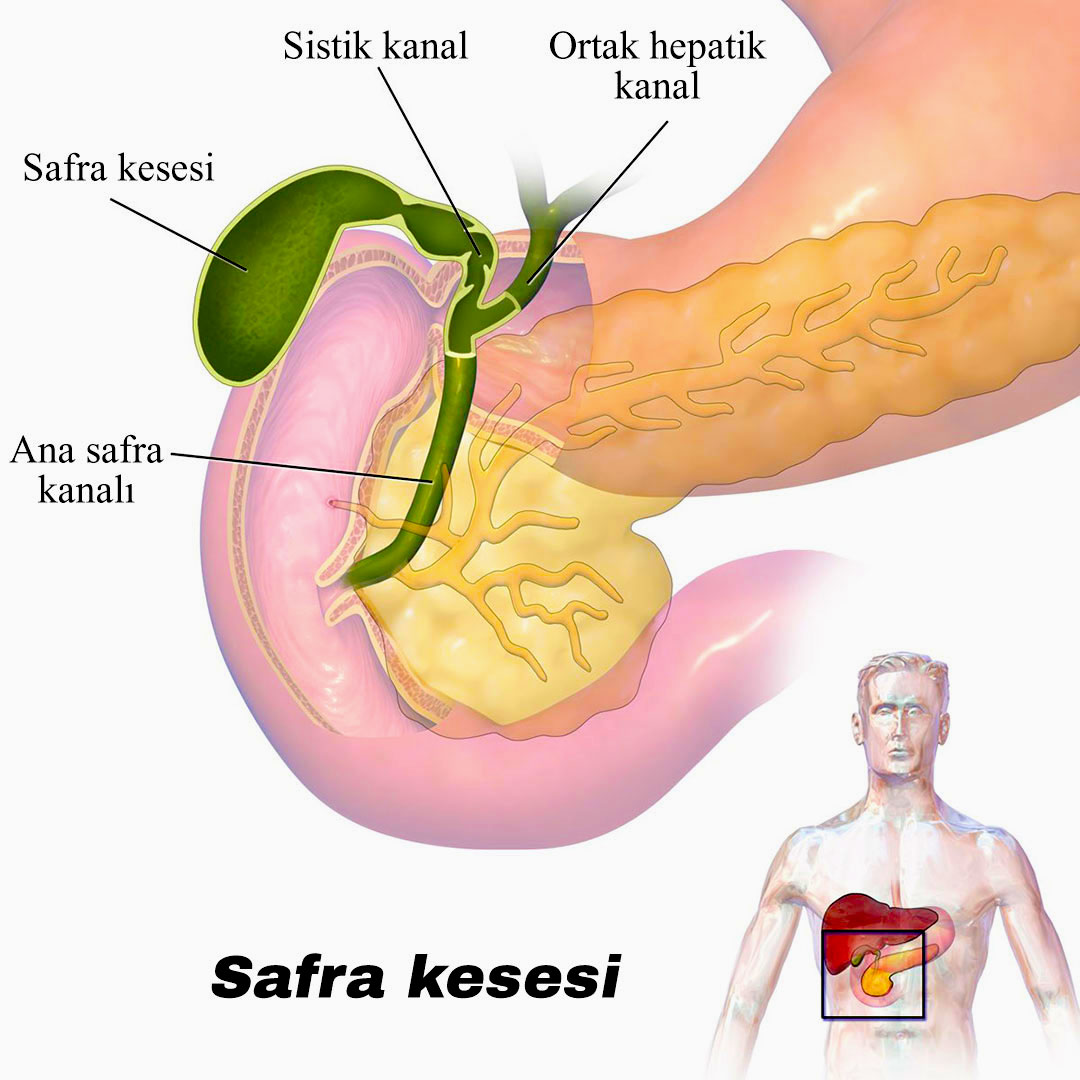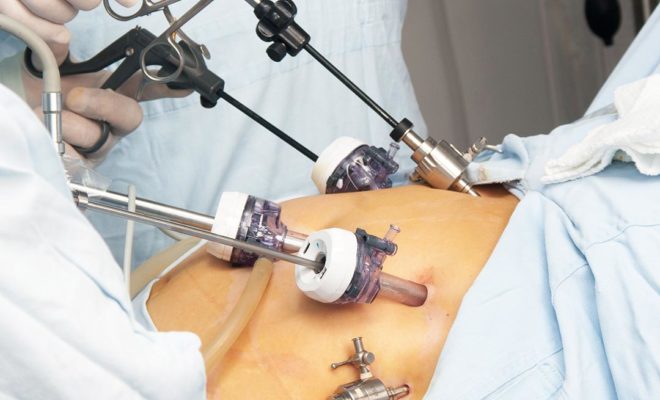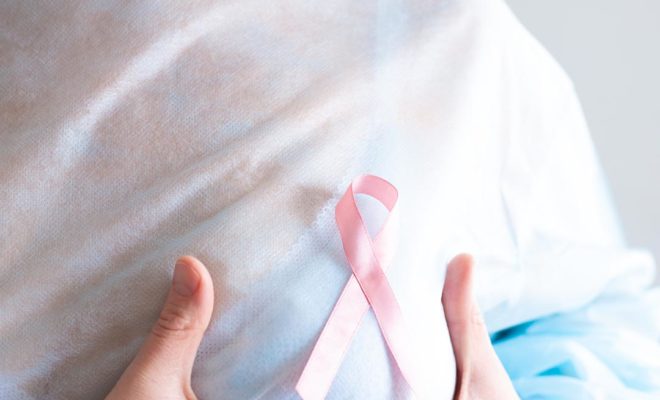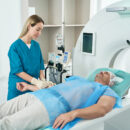Gallstones

Bile and biliary tract rightsInda
Bile is produced in the liver. Bile both helps excrete some substances produced in the liver and helps digestion. It plays an important role especially in the digestion of fatty foods. Bile produced in the liver is drained into small bile ducts within the liver. These channels combine within the liver to form larger channels. The bile ducts coming from both sides of the liver combine with the gallbladder duct to form the main bile duct (see picture). The gallbladder serves as a temporary storage for bile produced in the liver.
The gallbladder also helps the bile to thicken. The main bile duct, together with the pancreatic duct, empties into the second part of the duodenum. Because of this close relationship between the common bile duct and the pancreatic duct, gallstones can block not only the bile duct but also the pancreatic duct.
About gallstones
Although there are different types of gallstones that form by different mechanisms, the problems caused by all gallstones are similar. Gallstones are most commonly seen in the gallbladder. However, gallstones can occur in any part of the bile ducts. Therefore, removing the gallbladder does not mean that that person will never have gallstones again.
Although gallstones, as mentioned, are most commonly seen in the gallbladder, some people may also have stones in the main bile duct simultaneously. The treatment of the two conditions is different from each other. In addition, not all patients with stones in the gallbladder necessarily need to be treated, but individuals with stones in the main bile duct must be treated even if they have no complaints. Because the problems caused by stones in the main bile duct are much more frequent and serious.
What does gallstone disease mean?
It is important to understand the difference between the presence of gallstones and gallstone disease. Gallstone disease is mentioned when gallstones cause complaints or an obvious disease in the person (These diseases will be explained under the title of diseases related to gallstones). Therefore, not every individual with stones in the gallbladder has gallstone disease.
What are the symptoms of gallstone disease?
The most common complaints associated with gallstones are bloating, a feeling of fullness in the upper abdomen, and abdominal pain. The pain is often felt in the cavity and upper right part of the abdomen and may radiate below the right shoulder blade.
Gallstone disease, which is not uncommon, may occur with a sudden onset. Complaints such as fever and jaundice may occur along with a severe, suffocating abdominal pain that suddenly prevents you from sleeping, especially at night.
What are the diseases associated with gallstones?
Stones in the gallbladder can temporarily or permanently block the gallbladder duct. In case of temporary obstruction, patients present with severe abdominal pain called "biliary colic". In case of permanent obstruction, sudden gallbladder inflammation called "acute calculous cholecystitis" occurs. In this case, in addition to severe abdominal pain, systemic symptoms such as fever also occur.
Stones in the gallbladder can pass through the gallbladder duct and spill into the main bile duct. In this case, the common bile duct may be partially or completely blocked. A similar situation may occur in people whose gallbladder has been removed, due to gallstones formed in the main bile duct. As a result, latent or obvious jaundice occurs. If the obstruction persists, an inflammation of the bile duct (acute cholangitis) involving the entire bile duct may occur. Acute cholangitis is a very serious and potentially fatal disease.
Stones spilled from the gallbladder into the main bile duct can temporarily or permanently block the pancreatic duct. In this case, a sudden inflammation of the pancreas called “acute pancreatitis” may occur. Acute pancreatitis is a very serious and potentially fatal disease.
Less common diseases associated with gallstones include Mirizzi syndrome (a gallbladder stone blocks or erodes the main bile duct by pressing from the outside), gallstone ileus (gallbladder stones erode their way through the intestine and pass into the intestine, blocking it).
What methods are used in the diagnosis and follow-up of gallstones?
Gallstones are discovered as a result of tests requested due to related complaints or as a result of examinations for some other diseases. These can be generally classified as clinical (examination), biochemical (blood tests) and radiological (ultrasound, MRI, tomography).
The most commonly used blood tests are liver tests (AST, ALT, ALP, GGT, bilirubins). These are tests that show gallstone disease rather than showing whether you have gallstones or not.
Ultrasound is the easiest, cheapest and most effective method to detect gallstones. It does not cause serious discomfort to the person and does not pose a risk of radiation or allergy. Since it is widely available, it is also easy to reach. However, ultrasound cannot show stones in the common bile duct with the same accuracy. For this reason, MRI or tomography is preferred in people who are suspected of having stones in the main bile duct.
What do incidentally detected gallstones mean?
With the development and widespread use of diagnostic methods, it is frequently encountered that gallstones are detected incidentally during examinations performed for general health screening or for some other medical problems. For example, in people who require a kidney film due to urinary tract complaints, gallstones may be detected incidentally on the film. In short, gallstones that are detected during examinations performed for other reasons, even though they have no complaints about gallstones or have never had any problems with gallstones before, are called "incidentally detected gallstones". The treatment methods for incidentally detected gallbladder stones and gallstone disease are different from each other.
Yapılan büyük bilimsel çalışmalarda, tesadüfen saptanan safra kesesi taşları ile ilgili bazı bilgiler elde edilmiştir. Tesadüfen saptanan safra kesesi taşlarının bir kişide şikayete veya yukarında bahsi geçen safra taşları ile ilişkili hastalıklara yol açma olasılığı yıllık %2’nin altındadır. Tüm yaşam süresi için bu oran %20 civarındadır. Diğer bir deyişle, tesadüfen saptanan safra kesesi taşlarına sahip bireyler her seneyi %98’in üzerinde olasılıkla ve tüm hayatlarını %80 olasılıkla safra taşları ile ilgili hiçbir sorun yaşamayarak geçirecektir. Bu oranlara dayanarak güncel tıbbi kılavuzlar, tesadüfen saptanan safra kesesi taşlarında herhangi bir tedavi uygulamanın gerekli olmadığını belirtmişlerdir. Ancak, bazı durumlarda, tesadüfen saptanan safra kesesi taşlarında dahi tedavi gereksinimi doğar. Aşağıda belirtilen kişilerde bu tip bir gereksinim söz konusu olabilir:
- People who have previously had a gallstone-related disease (gallbladder inflammation, biliary tract inflammation, obstructive jaundice, pancreatitis, etc.),
- People who will have upper abdominal surgery for another reason (for example, reflux surgery),
- People who are organ transplant candidates,
- People who use drugs that suppress the immune system or have a disease,
- People who have difficulty or are unable to access healthcare in emergency situations,
- People with types of anemia that abet the formation of gallstones (hereditary spherocytosis).
Therefore, in light of current scientific evidence and worldwide standards, we do not recommend any medical treatment or surgery for people who are diagnosed with gallstones incidentally. We advise these individuals to contact us immediately if they have a complaint, otherwise to come for a check-up once a year.
At this point, it is necessary to emphasize two issues. First, the size and number of gallstones are very small in importance. However, since some scientific studies suggest that stones larger than 3 centimeters may be associated with gallbladder cancer, we recommend surgery to individuals who do not have a serious risk of surgery.
Secondly, as previously mentioned, detecting gallstones in any part of the bile ducts other than the gallbladder, even if incidentally, requires treatment.
How is gallstone disease treated?
Treatment of gallstone disease varies greatly depending on the location of the gallstones, the condition of the patient, and the condition of the disease.
In cases where there are only stones in the gallbladder, the most ideal treatment is surgical removal of the gallbladder. There is no treatment option of simply removing gallstones because gallstones are a result, not a cause. Gallstones are the products of an abnormally functioning gallbladder. Therefore, simply removing the stones does not cure the disease and results in the organ that is the source of the disease remaining in place. This may cause the formation of new gallstones. Therefore, the gallbladder is removed as a whole, including the stones inside. Depending on the disease and the patient's condition, surgery can be performed urgently or under normal conditions.
Safra asidi içeren bazı ilaçlar safra taşlarını eritmek için kullanılabilir. Ancak, bu ilaçlar sadece bazı tip safra taşları için etkilidir ve kişilerde hangi tip safra taşı olduğunu net olarak bilmek mümkün değildir. Bu nedenle, safra taşlarında ilaç tedavisi ile başarı elde etme şansı %60’ı geçmez. Ayrıca, başarılı olunsa da, yeniden taş oluşma olasılığı yüksektir.
Similar to kidney stones, lithotripsy treatment is also applied to gallbladder stones. However, as with drug therapy, success rates are low and recurrence rates are high.
Both in the world and in our clinic, drug therapy and lithotripsy treatment are used only in people who have a medical disability for surgery.
Stones in the common bile duct can be treated endoscopically, radiologically or surgically. In the endoscopic method, the bile ducts are accessed through endoscopy and the stones in the bile ducts are cleaned with special devices. However, this method only cleans the stones in the main bile duct, it cannot clean the stones in the gallbladder.
In cases where the endoscopic method cannot be used or is not successful, the stones can be pushed down into the intestine by entering the bile ducts radiologically and under ultrasound guidance. However, this method is more difficult and less effective than the endoscopic method.
In people who have stones in the main bile duct but endoscopic or radiological methods are not possible or successful, these stones can be removed by surgery performed by open or closed method.
Which method to choose for people with common bile duct stones is decided according to the patient's condition, whether he has had gallbladder surgery before, and the condition of the stones. Our clinic's primary preference for common bile duct stones is the endoscopic method. Both this endoscopic method, called ERCP (endoscopic retrograde cholangiopancreatography), and the surgical method are frequently and successfully applied in our clinic.
For people who have other health problems or other reasons, gallbladder surgery is not medically possible or is too risky, there are several options other than surgery. The first of these is to cut and widen the hole through which the main bile duct and the pancreatic duct open into the duodenum with endoscopy. Thus, the aim is for stones falling into the main bile duct to fall into the intestine without blocking the duct. However, the effectiveness of this treatment is lower than that of gallbladder surgery, and it has no protection against gallbladder inflammation.
A second option, mentioned above, is bile acid therapy. However, the effectiveness of this treatment is lower than the endoscopic method, and therefore drug therapy is generally applied together with endoscopic treatment, not alone.
Things to keep in mind
- The gallbladder does not produce bile; bile is produced by the liver and stored in the gallbladder; Therefore, in people whose gallbladder has been removed, bile production continues and gallstones may still form.
- Having gallstones in a person does not indicate or require that person to be sick; Gallstone disease is only mentioned in people with gallstones if they have complaints or diseases related to gallstones.
- “Gallbladder stones = surgery” does not
- Treatment is recommended for people with gallstones that cause complaints or gallstone-related diseases, in other words, those with gallstone disease.
- Gallbladder stones that are detected incidentally and do not cause any problems can be safely monitored, and treatment is recommended for these people only in certain special cases; because the risk of complaints or diseases due to gallbladder stones is very low in these people.
- The ideal treatment for gallstones is surgical removal of the gallbladder using a closed method; Drug treatment and lithotripsy treatment can also be applied for these types of stones, but their effectiveness is low and new gallstone formation is common after treatment.
- Stones located in parts of the bile ducts other than the gallbladder must be treated, whether or not they cause any complaints or disease.
Last word
All of this information was obtained from publications and books based on current scientific data. This article has been prepared for the sole purpose of providing preliminary information to individuals. Therefore, it is not appropriate to make a decision on your own, based on this information, without consulting your physician. You need to meet with the relevant physician to get clear information about your condition, to clear your questions and, if necessary, to determine what your treatment will be like.
Op. Dr. Cemal Seyhun
General surgery specialist
Contact Us For Appointment:
Telephone line: 0392 444 3548 (ELIT)
Contact Form: https://www.elitenicosia.com/iletisim/

















